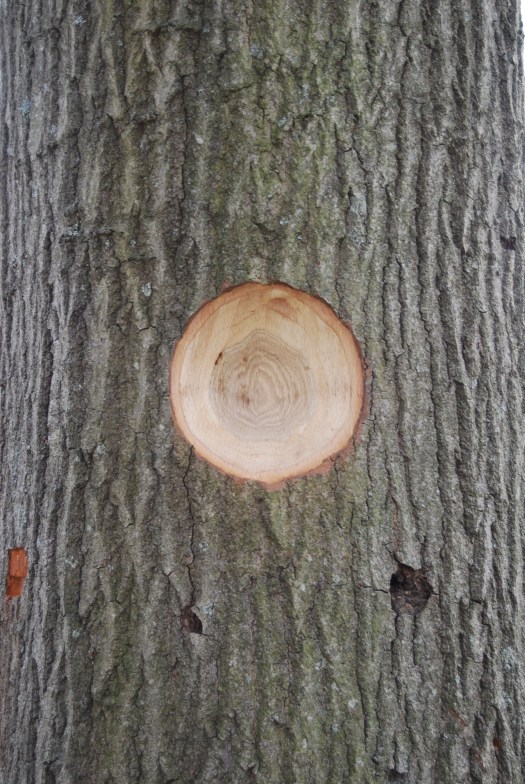This recording is a result of embedding two contact microphones into either side of a tree trunk as the tree is cut down.
tree carving
carving from allée pin oaks with an angle grinder, 2017. processual material encounter with the temporal archive of the tree.

The goal of this project is to attempt to disorder the cultural archive of the tree with an experiential practice that engages with one tree—and perhaps collapses, ever so slightly, the remove between us. I use an angle grinder to make a hollow in the living material of a pin oak in the campus allée that would shortly be felled. The operation is grounded in experimental veins of cultural geography and archaeology that use performative landscape practices, specifically those involving movement and feel, to foreground the body in the revelation of the human and nonhuman world. The embodiment of the process makes for a lived experience of the material chronology of a tree, its otherness/closeness, and the tightly interlocked grains and folds of its matter—haptic exchanges mediated by a tool across time. The outcome is a kind of intimacy with a tree. The resultant concavity of its substance is a subtly-evolving processual artifact, and an accompanying essay a translation of the practice.



Tree Listening
The tree quartet imagines four trees roughly situated at four corners of a piece of the allee as receivers, transmitters, conduits for sound. The trees listen, they perform, they are performed by people, wind, birds. Each tree is equipped with a contact microphone and a guitar amplifier situated to create a space which gathers the four trees and begins to depict the soundscape of the trees as individual attentive bodies and the allee as a collective array of antennae. (recording by Jesse Vogler)

[rooted]
Who can impress the forest, bid the tree
Unfix his earthbound root?
—William Shakespeare, Macbeth IV.1.95-96
[WS means here impress, as to conscript or press into service…]
When we plant the tree
ON THE OCCASION OF FUTURE TREE PLANTINGS
with reference to “Tree-Planting Day,” Calvin Milton Woodward, 1905
What do we plant when we plant the tree?
We buy eighty years for the next allee;
We look to the past but mostly ahead;
We often ignore the tree now dead
Decaying gently in the new entry;
We plant to forget when we plant the tree.
What do we plant when we plant the tree?
We know the resources historically—
We plant a pole, a mast, a winter’s fuel;
A rifle, an ax, more violent tools;
We know the harvests did come to be;
We planted to deploy when we planted the tree.
What do we plant when we plant the tree?
We’ve read about instrumentality:
We plant for trees to serve our needs;
We perpetuate this, we save their seeds,
Force shape on their neutrality;
We plant an object when we plant the tree.
What do we plant when we plant the tree?
We plant to project authority;
We plant in grids, Cartesian perspectives;
We dominate nature, acculturate spaces;
We educate with due civility;
We plant to contain when we plant the tree.
But come, my friends, it isn’t all bad:
We plant, we’ve said, to give power to plans;
By planting a tree, we’ll do more than deploy—
The shade of a tree we can always enjoy;
We plant for places to move and debate
with raised glasses, for we plant to create.
The terrain is contested, it always will be,
And we start all again when we plant the tree.

with thanks.
Post Tree Day

Tree Day

Tree Walk
Tree Walk
Sunday May 21 2017
2:30pm
Washington University entrance, Lindell at Skinker
In partnership with the department of walking | http://www.dptwlk.org

This walk promotes the bodily experience of the Brookings Drive Pin Oak allée one last time. Participants will complete an orchestrated mediation between the vastness of tree body and individual body by materially mapping the interconnected condition between these beings. Each participant will partner with one tree, and begin their solo walk from that tree into the vastness of the allée — each establishing their individual trajectory, interacting with other participants and trees along the way. Pace, direction and interaction with fellow participants matter.
And so, while you begin at one tree – you go on a journey ultimately mapping out the constellation of trees and their interconnectivity that makes this landscape an allée. The material result is a mapping of individual paths, but also a mapping of interaction, and ultimately connectivity.
Tree Taste

Hacking into the final weekly
GAC happy hour to congregate
around this tree and sample beers
brewed with oak elements.
